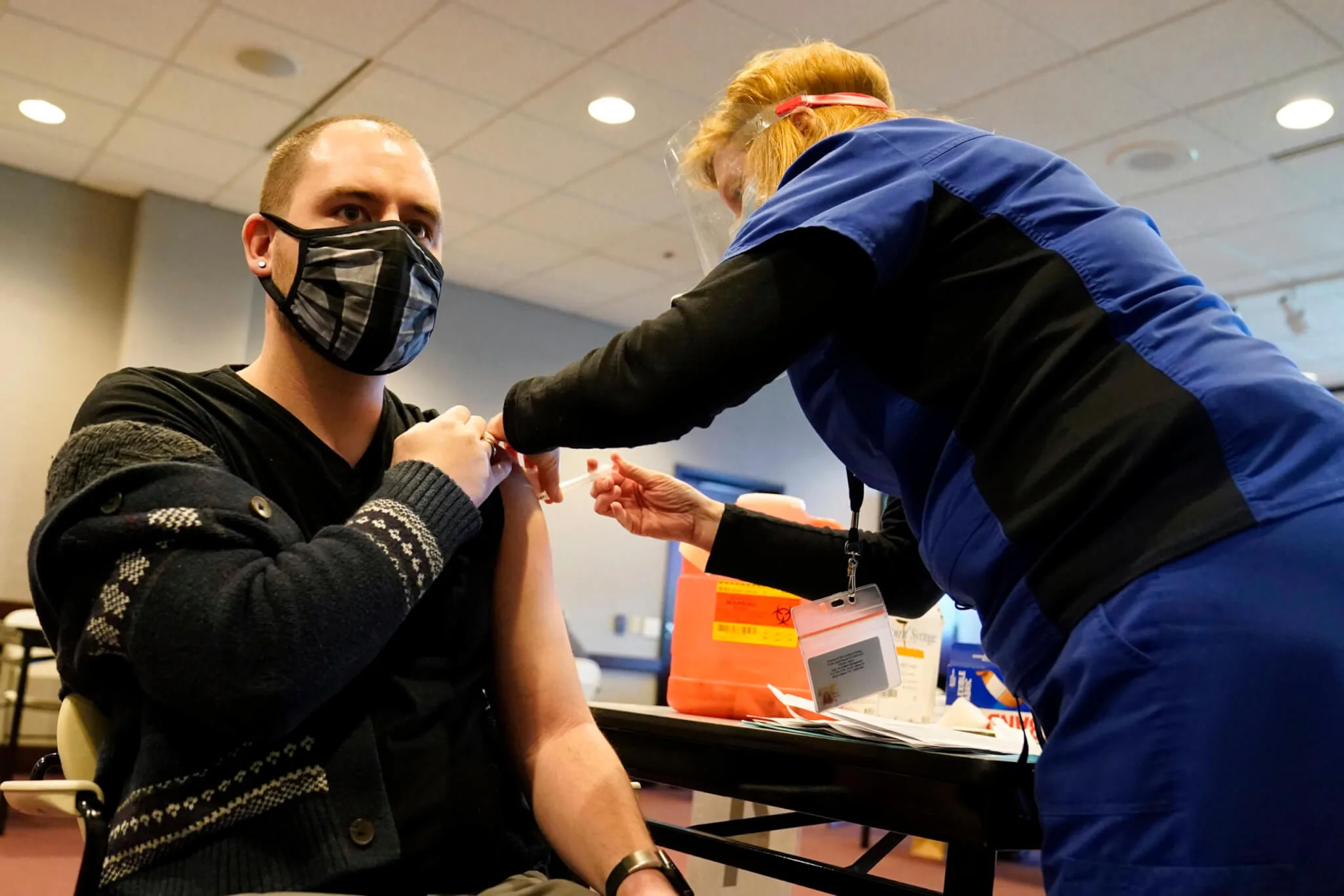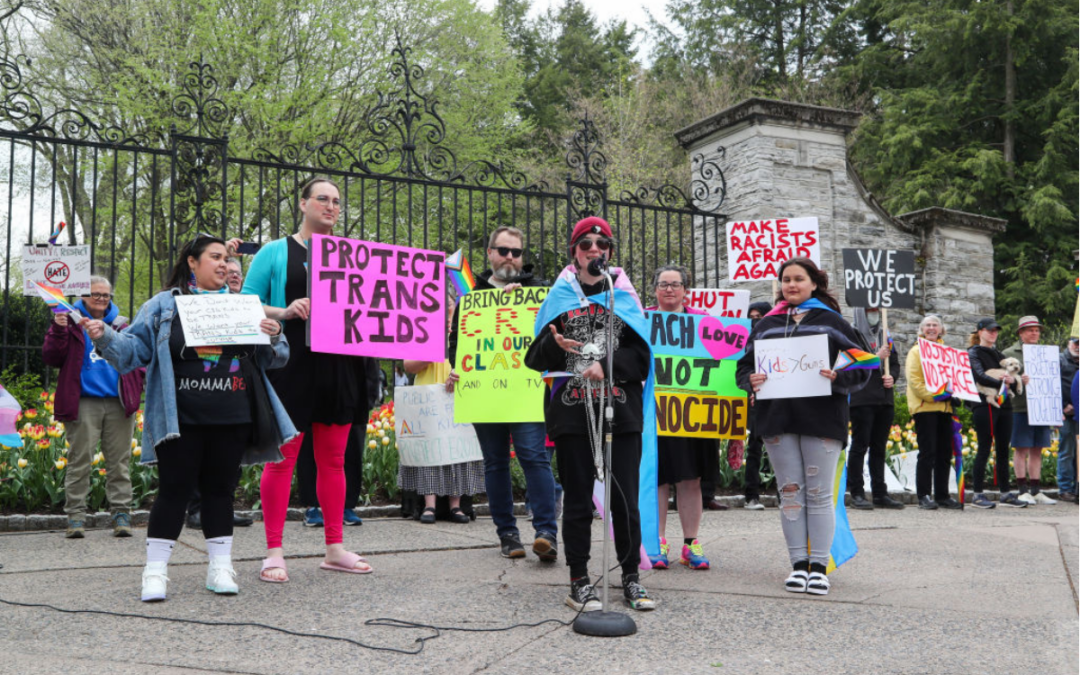
Penny Cracas, right, with the Chester County, Pa., Health Department, administers the Moderna COVID-19 vaccine to Robert Dando, a school district nurse, at the Chester County Government Services Center, Tuesday, Dec. 29, 2020, in West Chester. (AP Photo/Matt Slocum)
Pennsylvania health officials say there are several obstacles to distributing the coronavirus vaccines across the state. We take a look at what they are.
Pennsylvania has plenty of doses of the coronavirus vaccines. The problem is getting those shots into arms.
State Secretary of Health Dr. Rachel Levine has repeatedly said it’s going to take months. But the quicker health officials get those doses into people’s arms, the quicker the state’s economy can open back up completely.
As the fifth most populous state, Pennsylvania has received the fifth most doses from the federal government. However, it is sixth in number of doses distributed and 24th in percentage of doses distributed.
The state had received a total of 974,725 doses as of Wednesday through the federal government’s Warp Speed program, according to the Centers for Disease Control. It has administered at least 341,948 of those doses. Illinois, in contrast, has nearly 200,000 fewer people than Pennsylvania. As of Wednesday, it had received 71,624 fewer doses, but had distributed roughly 5,057 more vaccines.
While those numbers have led to some criticism of the state, Gov. Tom Wolf is standing by his department of health.
“They have done a phenomenal job of getting this out in really tough circumstances,” Wolf said Tuesday.
The Obstacles to Distributing the Vaccines in Pennsylvania
The first problem deals with the vaccines themselves.
The Pfizer vaccine has to be stored at -70 Celsius (-94 Fahrenheit). The Moderna vaccine has to be stored at -20 Celsius (-4 Fahrenheit), which is slightly colder than a household freezer. Levine has said that many rural healthcare facilities do not have the ability to store the Pfizer vaccine.
In the first week of vaccine distribution, when the Pfizer vaccine was the only one available, those doses couldn’t be distributed in many rural communities, Levine said. Instead, they stayed in more populous areas.
The second problem comes from the friction between the federal government, which runs the program, and the state.
State health officials don’t often know when and where the vaccines are being distributed until the last minute. And sometimes, the last minute is late in the week, which makes it hard to schedule vaccinations.
“What we need from Operation Warp Speed is more specific detail about how much vaccine we’re getting and exactly when we’re getting it,” Levine said. “We want to know how much vaccine is going to go to specific hospitals and the more specific details that we have about that, the better we can prepare.”
Another obstacle is the current strain on hospital personnel. Hospitals have to administer their vaccines while they’re still caring for patients. This is an added responsibility on the staff in the hospitals and long-term care facilities.
Other Factors That Affect Pennsylvania’s Vaccine Distribution Numbers
There are two other issues that don’t affect the administration of vaccines, but do have an impact on the percentage of vaccines administered reported by the CDC.
When the federal government announces the state is getting, for example, 40,000 vaccines this week, that doesn’t mean the state gets all of those doses on Monday. Many of them can come later in the week. However, those numbers are included in the totals that are used to compute the percentage.
There is also a lag in reporting on the doses that are administered. Levine said the delay can be up to 72 hours from long-term care facilities and 24 hours from hospitals.
“I think there is a difference in the number that we have and the number that we’ve given,” Levine said.
Pennsylvania isn’t alone in having a tough task.
Improving Pennsylvania’s Vaccine Distribution Numbers
Levine has said the state has been improving its distribution. By Jan. 4, the state had distributed 20,000 doses in a day one time. Since then, it has administered more than 20,000 doses in a day five times.
From Jan. 6 to Jan. 12, the state administered 143,176 doses. In the previous seven days, it had distributed 83,359.
States with Similar Vaccine Distribution Struggles
Just one of the 10 states that received the most doses is in the top 10 states when it comes to the percentage of doses administered. Texas, with 46.8% doses administered, ranks 9th.
California has received the most doses, with 3,286,050 and has administered 24.8%, which is 41st.
Of the 10 states with the most doses distributed to them, Texas (46.8%), Illinois (38.4%), Florida (37.8%), Ohio (36.0%), and New York (35.7%) have distributed higher percentages than Pennsylvania. Virginia (25.3%), North Carolina (23.9%), and Georgia (17.7%) are below Pennsylvania.
Six states—North Dakota, West Virginia, Connecticut, South Dakota, Montana, Tennessee—have administered 50% or more of their vaccines. Four of those states are among the 12 least populous in the nation. The others—Connecticut and Tennessee— are small enough to fit inside Pennsylvania.

For Rep. Susan Wild, supporting PA families includes reproductive rights and much more
Rep. Susan Wild wants to be very clear with Pennsylvanians: Donald Trump is committed to taking away women’s reproductive freedom, but he is not...

School districts working with anti-LGBTQ groups can cost your kids’ schools millions
Parents across South Central Pennsylvania are worried about the potential financial impacts working with anti-LGBTQ groups may have on their school...

VIDEO: Trump distances himself from his anti-abortion views
Donald Trump appeared on WGAL on Tuesday and continued to distance himself from his anti-abortion views claiming that reproductive rights are now a...

VIDEO: Community pushback gets school board to rescind decision on denying gay actor’s visit
Cumberland Valley School Board offered a public apology and voted to reinstate Maulik Pancholy as a guest speaker a week after the board voted to...

VIDEO: Project 2025 brings nuclear armageddon back into vogue
Project 2025 is a titanic document, with plans ranging from cutting half of all government employees to targeting reproductive rights on a scale...




